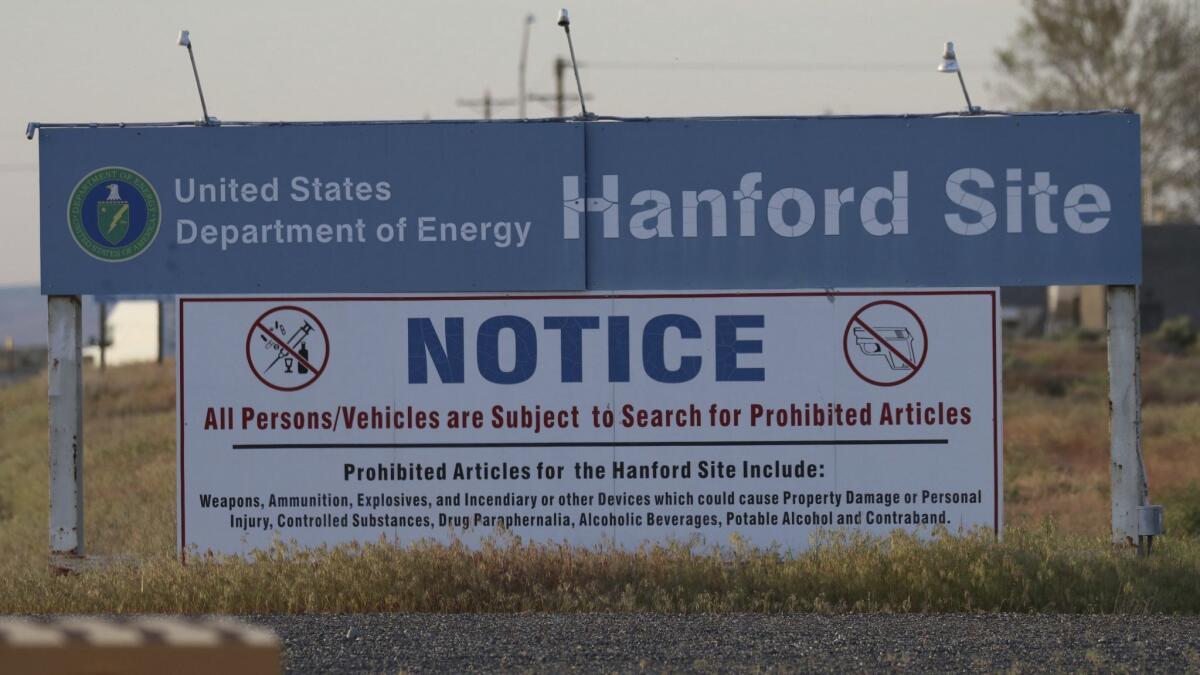Must Reads: Hidden danger: Radioactive dust is found in communities around nuclear weapons sites
At the dawn of the nuclear age, the Franklin D. Roosevelt administration placed the nation’s major nuclear weapons production and research facilities in large, isolated reservations to shield them from foreign spies — and to protect the American public from the still unknown risks of radioactivity.
By the late 1980s, near the end of the Cold War, federal lands in South Carolina, Tennessee, New Mexico, Colorado, Ohio and Washington state, among other places, were so polluted with radionuclides that the land was deemed permanently unsuitable for human habitation.
That much has long been accepted as a price for the nation’s nuclear deterrent. But a far more complex problem could emerge if recent research is correct.
Studies by a Massachusetts scientist say that invisible radioactive particles of plutonium, thorium and uranium are showing up in household dust, automotive air cleaners and along hiking trails outside the factories and laboratories that for half a century contributed to the nation’s stockpile of nuclear weapons.

The findings provide troubling new evidence that the federal government is losing control of at least some of the radioactive byproducts of the country’s weapons program.
Marco Kaltofen, a nuclear forensics expert and a professor at Worcester Polytechnic Institute, said he collected samples from communities outside three lab sites across the country and found a wide variation of particle sizes. He said they could deliver lifelong doses that exceed allowable federal standards if inhaled.
“If you inhale two particles, you will exceed your lifetime dose under occupational standards, and there is a low probability of detecting it,” he said.
A peer-reviewed study by Kaltofen was published in its final form in May in the journal Environmental Engineering Science.
Kaltofen, who also is the principal investigator at the nuclear and chemical forensics consulting firm Boston Chemical Data Corp., released a second study in recent weeks.
The Energy Department has long asserted that small particles like those collected by Kaltofen deliver minute doses of radioactivity, well below typical public exposures.
One of the nation’s leading experts on radioactivity doses, Bruce Napier, who works in the Energy Department’s lab system, said the doses cited by Kaltofen would not pose a threat to public health.
Such assurances have been rejected by nuclear plant workers, their unions and activists who monitor environmental issues at nearly every lab and nuclear weapons site in the country.
Jay Coghlan, executive director of Nuclear Watch New Mexico, cited a longhistory of denial about the claims of “down winders,” the residents of Western states who were exposed to radioactive fallout fromatmospheric weapons testing.
“We cannot trust self-reporting by the Department of Energy,” he said. “I don’t accept that low levels of radioactivity have no risk.”
Tom Carpenter, executive director of another watchdog group, the Hanford Challenge in central Washington state, said that the Energy Department as recently as last year released an unknown quantity of radioactive particles during demolition of a shuttered weapons factory, the Plutonium Finishing Plant.
After a series of three releases during 2017, the Energy Department shut down the demolition and has yet to resume it. Forty-two workers were exposed in the incidents.
“If you work in a coal mine, you go home with coal dust on you,” Carpenter said. “Same with a textile mill; you go home with cotton dust. These Hanford workers went home with plutonium dust.”
The second study by Kaltofen, completed in August, reported that fairly high radioactivity levels were found in 30 samples from the communities around the Hanford nuclear site, near Richland, Wash. The samples found contamination on personal vehicles driven inside the Hanford site that would leave mechanics exposed if they worked around the vehicles, the report said.
Kaltofen also reviewed an internal study in March by an Energy Department contractor, Washington River Protection Solutions, that found a calculated potential dose of 95 millirems for workers, roughly 10 times the federal Environmental Protection Agency standard.
Kaltofen said a broader independent study should look at residual contamination around Hanford. An Energy Department spokesman at the Hanford site said the office had no comment on the studies.
For his studies, Kaltofen collected samples outside the Los Alamos National Laboratory in New Mexico, the former Rocky Flats weapons plant near Denver and the Hanford site.
The samples were collected from the crawlspaces of homes, a trailer park office, vacuum cleaner bags, automotive air filters, furnace filters and along a hiking trail.
He subjected those samples to electronic microscopy analysis to determine exactly what type of element was emitting radiation. He identified isotopes of cesium, thorium, uranium and plutonium, all the results of building nuclear weapons parts.

The communities surrounding these facilities have long adapted to the reality that they are near radioactivity, though they are not willing to take risks that compromise their health. Kaltofen’s sampling found some very high levels of contamination in Los Alamos’ Acid Canyon, a recreational area near a community pool and skate park.
The canyon was used during the Manhattan Project and for years later to dump nitric acid wastes from plutonium processing, sending toxic and radioactive effluent down the steep ravine.
The Energy Department conducted a cleanup in 2001, aiming to reduce radioactivity levels to the standard of “as low as reasonably achievable.” The lab takes the position that the cleanup lowered doses to recreational users well below federal guidelines.
“I trust the cleanup, but I am aware that it would be impossible to clean it up entirely,” said Jody Benson, a Los Alamos resident and chair of the local Sierra Club chapter, who hikes in the canyon almost every day. “Because I grew up here, I am a bit cavalier about radioactivity, but that doesn’t mean I am not concerned. I’d support further research.”
Greg Mello, a former state environmental inspector, said he has hiked through the dusty canyon a number of times.
“I have met a lot of people bitter about all the time they spent playing in Acid Canyon when they were little,” Mello said. “There is sure to be plutonium and other radionuclides around Los Alamos, and there are certain to be hot spots.”
Radiation is a known cause of cancer. Much of what is known about the health effects of radioactivity derives from U.S. studies of survivors of the Hiroshima and Nagasaki bombings during World War II.
Even today, determining how large a dose a person gets from a radioactive exposure is highly complicated, said Napier, one of the nation’s top experts on radioactive health effects at the Energy Department’s Pacific Northwest National Laboratory and a member of the National Council on Radiation Protection and Measurements.
Napier noted that uranium and thorium are heavy metals, much like lead, which limits their transport through the air.
“Large and dense particles usually do not travel far in the air; they are essentially like small grains of sand and fall out close to the source,” Napier said in an email exchange. “They can bounce along the ground for short distances in higher winds, but usually end up stuck to the soil surface eventually.
“Unless we were to find a large number of them in one place, I do not consider these individual particles to be a particular public health hazard. The big ones are too large to be respirable; the small ones have very small radioactive contents,” he said.
Napier said that average radioactivity exposures for Americans are going up, largely because of medical use of radiation. On average, Americans get about 100 millirems from cosmic gamma radiation, 200 more millirems from radon doses and 300 millirems from medical exposures, he said. The lifetime estimates of exposure from nuclear plant dust are much lower than that, he said.
But Kaltofen said such calculations miss the mark.
A worker’s exposure to radioactivity, such as walking by a radioactive substance or having particles cling to clothing, is checked by monitors and badges worn by workers at plant sites. Such exposure is like a medical X-ray, which delivers a momentary dose. But inhaling a small particle of plutonium or thorium can go unnoticed by such monitors and deliver a lifetime of alpha radiation right next to lung tissue, Kaltofen said.
“You can walk through a portal monitor without setting it off, but you can get a substantial amount of energy from particles in the body,” he said.
Follow me on Twitter @rvartabedian
More to Read
Start your day right
Sign up for Essential California for news, features and recommendations from the L.A. Times and beyond in your inbox six days a week.
You may occasionally receive promotional content from the Los Angeles Times.







